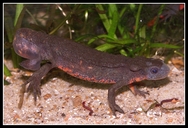|
Cynops pyrrhogaster (Boie, 1826)
Japanese Newt, Japanese fire-bellied newt Subgenus: Cynops | family: Salamandridae subfamily: Pleurodelinae genus: Cynops |
| Species Description: Boie, H. (1826). "Merkmale einiger japonischen Lurche." Isis von Oken 18: 203–215. | |
 © 2005 Henk Wallays (1 of 63) |
|
|
|
Description Males are on average smaller than females. Average length of 20 males of Hiroshima: 86.5 mm, average length of 20 females of Hiroshima: 104 mm. Head is longer than broad; rectangular when viewed dorsally, truncated when viewed laterally. Eyes laterally placed. Vomeropalatine teeth extending posteriorly to a point near corners of mouth; run parallel then diverge. Nostrils anteriorly placed, distance from each other is less than their distance from eyes. The snout-vent length is approximately three times distance from anterior point of snout to gular fold. Digits long and without webbing; third finger longest, third and fourth toes nearly equal in length. Fingers and toes slightly contact one another when laterally adpressed. Tail laterally compressed; dorsal and ventral fins are parallel and taper at posterior end. Smooth vertebral ridge from neck to tail, running continuous with dorsal fin ridge. Parotoid gland is large, compressed, and almost continuous with a dorso-lateral glandular ridge, which is cut by transverse grooves into a series of bead-like glands; ventro-lateral glandular ridge also present from axilla to groin. Circular gland also present at the antero-dorsal insertion point of the thigh between the two previously mentioned glandular rows. Males are much more glandular during breeding season. Has rugose skin (Thorn and Raffaelli 2001). Dorsum black, sometimes brownish-black, and may sometimes contain small yellow spots on the back along the dorso-lateral glands (Thorn and Raffaelli 2001). Ventral color is brick red, vermilion, carmine, with variable black mottling. Stejneger (1907) describes specimens collected by Dr. Hugh M. Smith from Kiusiu and Shikoku with a black or blackish green dorsum; blood red with dark green mottling or symmetrical streaks ventrally; and in some specimens back is lighter green and sides of tail steel blue. Although most of the specimens look alike, their variation comes from their ventral patterns (Stejneger 1907). There is sexual dimorphism in this species with males having a “filament” at the end of the tail and less rugose skin. Additionally, blue-purplish coloration can be found on the tail, belly, and other parts of male’s body during the breeding season (Thorn and Raffaelli 2001). Additionally, as of 2016, six subspecies have been identified that can be differentiated based on geography, morphology, and behavior (Kawamura 1956, Sawada 1961, 1963 - morphological, 1963 - sexual, Shimada et al. 2016). Those races are: Atsumi Race Hiroshima Race Intermediate Race Kanto Race Tamba/Sasayama Race Tohuko Race Distribution and Habitat Country distribution from AmphibiaWeb's database: Japan
Life History, Abundance, Activity, and Special Behaviors Metamorphs emerge onto land from July to September. Sexual maturity is reached in 2 to 3 years and then they return to the water to breed, at which point they may remain aquatic for the rest of their lives (Thorn and Raffaelli 2001). Larva Larvae have limbs with 2 digits and reach a total body length of 45 - 55 mm (Thorn and Raffaelli 2001). **Note:** Previously stated, "Larvae require 10-12 months to metamorphose." attributed to (Thorn and Raffaelli 2001). However Yukio Ichioka Trends and Threats Possible reasons for amphibian decline General habitat alteration and loss
References
Kawamura, T. (1956). ''Isolating mechanisms in Japanese amphibians.'' Population Genetics. T. Komai and K. Sakai, eds., Baifu-Kan, Tokyo, 143-162. Sawada, S. (1961). ''A local variation of the mating behavior in the Japanese newt, Triturus pyrrhogaster.'' Zoological Magazine, 70(10), 20-25. Sawada, S. (1963). ''Studies on the local races of the Japanese newt, Triturus pyrrhogaster Boie. I. Morphological characters.'' Journal of Science, Hiroshima University, B(21), 135-165. Sawada, S. (1963). ''Studies on the local races of the Japanese newt, Triturus pyrrhogaster Boie. II. Sexual isolation mechanisms.'' Journal of Science, Hiroshima University, B(21), 167-180. Stejneger, L. H. (1907). Herpetology of Japan and Adjacent Territory, United States National Museum Bulletin 58. Smithsonian Institution, Washington, D. C.. Thorn, R. and Raffaelli, J. (2001). ''Genera Cynops.'' Les Salamandres. Societé Nouvelle des Editions Boubée, Paris, 305-313. Originally submitted by: Raul E. Diaz (first posted 2003-11-19) Description by: Ann T. Chang (updated 2023-02-21)
Distribution by: Ann T. Chang (updated 2023-02-21)
Life history by: Ann T. Chang (updated 2023-02-21)
Larva by: Ann T. Chang (updated 2023-02-21)
Trends and threats by: Ann T. Chang (updated 2023-02-21)
Edited by: Kellie Whittaker, Ann T. Chang (2023-02-21) Species Account Citation: AmphibiaWeb 2023 Cynops pyrrhogaster: Japanese Newt <https://amphibiaweb.org/species/4245> University of California, Berkeley, CA, USA. Accessed Jan 10, 2025.
Feedback or comments about this page.
Citation: AmphibiaWeb. 2025. <https://amphibiaweb.org> University of California, Berkeley, CA, USA. Accessed 10 Jan 2025. AmphibiaWeb's policy on data use. |




 Raffaëlli Account
Raffaëlli Account Map of Life
Map of Life